
(Photo: PBOT)

Portland is changing and so are our streets. Whether those changes help or harm our city is entirely up to us.
One of the biggest changes is an increase in the amount of people who drive. Congestion is everywhere and one of the victims are bus users. During peak hours especially, they get stopped behind single-occupancy vehicles. It’s maddening when public transit is delayed by such an inefficient and costly mode of transportation.
One way the Portland Bureau of Transportation has decided to deal with this problem is to focus on getting cars out of the way of buses. For the past year or so they’ve worked on the Enhanced Transit Corridors plan, which is now in draft form and open for public comment (until March 26th, sorry for late notice). The plan aims to institutionalize the concept of “enhanced transit” within the City of Portland, and to identify projects that will improve transit capacity, reliability and travel time.
Before I share my takeaways, here are some kicker quotes from the plan that sum up where PBOT is coming from:
“Portland and the region is at a critical point in the evolution of our transit network. Our buses are increasingly stuck in traffic, and each year resources for transit hours are spent just trying to keep up schedules due to congestion, reducing the potential funding to increase transit service. This critical point calls for redoubling our efforts to improve transit…
A common criticism of the existing transit network is that it takes too long to cross downtown Portland or to get to any destination compared to driving. We are losing the attractiveness of transit every year as buses are stuck in traffic, not taking people where they want to go at a competitive travel time.”
Here are my takeaways…
We desperately need better bus service

The trendlines for congestion, population growth, and transit use are not in sync. Transit use in Portland is stagnant, while congestion increases and the experts project Portland will add another 260,000 new residents by 2035. “Without substantial improvements to the bus and streetcar network,” the plan states, “it is very likely that transit service speed and reliability will continue to deteriorate.”
Portland’s transit mode share goal is 25 percent of all trips by 2035 (part of a goal to have 70 percent of all commuters do something other than drive a car). While MAX light rail has increased in recent years, the amount of people using local buses drags down the current transit mode share down to 12 percent — the same level since about 2000. PBOT recognizes that TriMet already has an established “backbone” of frequent service routes like the 4, 72, 20 and 75. They’ve smartly focused this plan on those routes.
Buses are flexible, relatively cheap (compared to MAX and freeways), and when done right they can integrate very nicely with bicycle use. If we don’t make them work better, we’re in a lot of trouble.
Too much driving is screwing everything up

We could write volumes about how car abuse is hurting Portland. But let’s look specifically at its impact on bus service.
From the plan:
“… buses and streetcars are increasingly stuck in traffic, leading to longer travel times and less travel time reliability, making bus and streetcar transit less competitive with driving, bicycling, and other transit modes.”
And here are the charts to back that up:

Advertisement
PBOT wants into the transit game
Transit plays a crucial role in whether or not Portland reaches its transportation goals. The problem is, PBOT doesn’t control much of it. Beyond funding operations and some other ties, TriMet manages their own bus and MAX service and Portland Streetcar Inc. operates separately from the City of Portland. PBOT currently has staff with titles of Bicycle Coordinator, Freight Coordinator, and Pedestrian Coordinator — but not Transit Coordinator.
That might be changing.
The ETC plan feels like a serious attempt by PBOT to play a larger role in transit. The plan calls for a “closer relationship and active cooperation between transit operators and PBOT” and the development of a City Transit Program. PBOT also wants to, “Develop future MOUs [memorandums of understanding] and IGAs [inter-governmental agreements] to further forge TriMet and PBOT partnerships.”
And you know they’re serious when they put money on the table. PBOT wants to create a new program for “transit priority spot improvements” that would be funded at $500,000 annually (the fact that the plan comes out when the agency is flush with cash for the first time in decades probably isn’t a coincidence).
A subway!

It’s nice to see PBOT share a bold vision of anything these days. Look closely at their “new transit vision” and you’ll see a “potential subway” under the Willamette River between downtown and the Lloyd District.
Listed as a possibility to be built in the next 20-40 years, PBOT calls the subway one of several major new transit “concepts” that can, “make transit more attractive and competitive while maintaining the basic accessibility that transit needs to attract riders.”
Red is for buses only

If the ETC gets adopted by City Council, PBOT is going to join an ongoing study at the Federal Highway Administration that’s analyzing the effectiveness of red-colored lanes for buses. San Francisco is already using red for bus-only lanes.
PBOT took this same step with green for bike lanes (and bike boxes).
What does this mean for bikes?

It’s mostly good, but I remain cautiously optimistic.
The ETC plan is just one part of PBOT’s larger work to redefine our streets. That new definition pushes single-occupancy driving nearly out of the picture and elevates cycling, walking, and transit into starring roles. Keep in mind that PBOT isn’t doing this ETC work in a vacuum. In the near future, when they look at a street to fix a major safety problem, they’ll also lean on the ETC plan to determine whether transit upgrades could be made at the same time. Likewise with bike-centric projects.
In fact, PBOT is already talking about an integration between the ETC and the Central City in Motion plan. That’s the plan to build a network of family-friendly bikeways they’ve been working on for many years (more to come on that soon).
But their are pitfalls. As we know, right-of-way is precious and more space for buses means less space for everything else. It’s possible for buses and bikes to coexist wonderfully together — but if things like bus-only lanes, floating transit islands, and curb extensions (all recommended in the ETC toolkit) aren’t built with low-stress cycling in mind the result could be a reduction in service for bicycle users.
For example, below is a graphic from the plan of a potential enhanced transit project on NE Sandy. Keep in mind that Sandy also needs a protected bikeway in the future. Can we do all the stuff in the graphic below and still make Sandy the great cycling street it’s meant to be?
I’m glad to see this potential for conflict is acknowledged in the ETC plan. “Great care must be taken when implementing… treatments that can reduce the safety and comfort of people walking or bicycling, or preclude the future provision of appropriate bicycle facilities on streets classified for bicycle use,” reads one passage. Another section warns that according to the National Association of City Transportation Officials (NACTO), “[Shared] bus-bike lanes are not high-comfort bicycle facilities, and are not a substitute for dedicated bikeways,” and that, “Special care must be taken not to require bicycle and bus traffic to mix at high speeds.”
Learn more about the ETC plan at PBOT’s website.
— Jonathan Maus: (503) 706-8804, @jonathan_maus on Twitter and jonathan@bikeportland.org
Never miss a story. Sign-up for the daily BP Headlines email.
BikePortland needs your support.


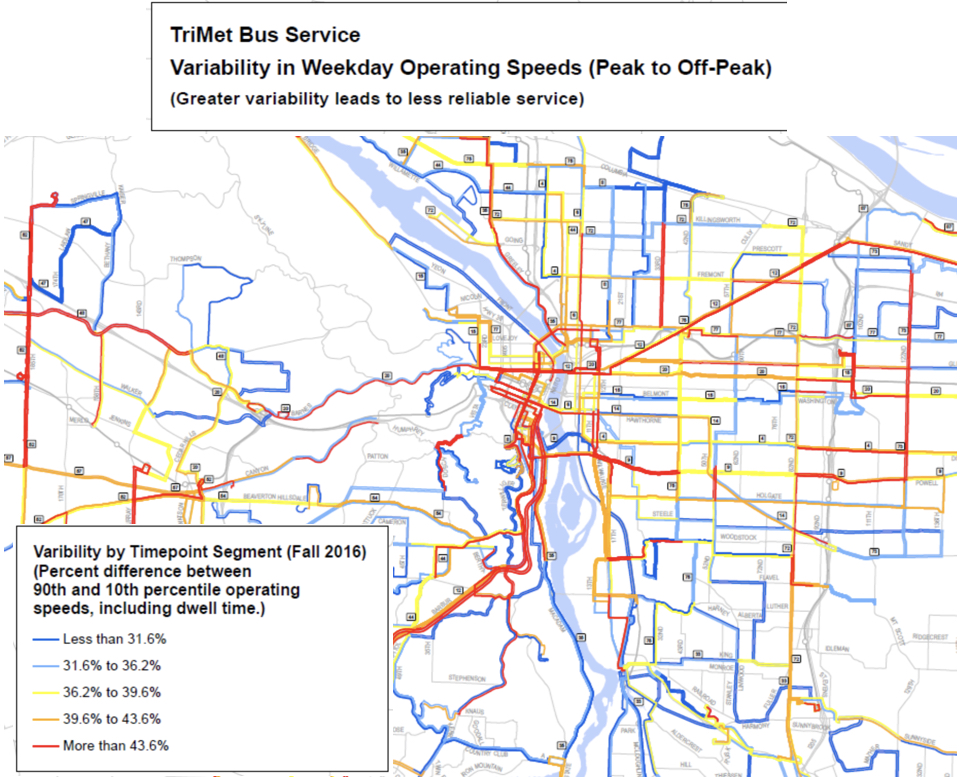
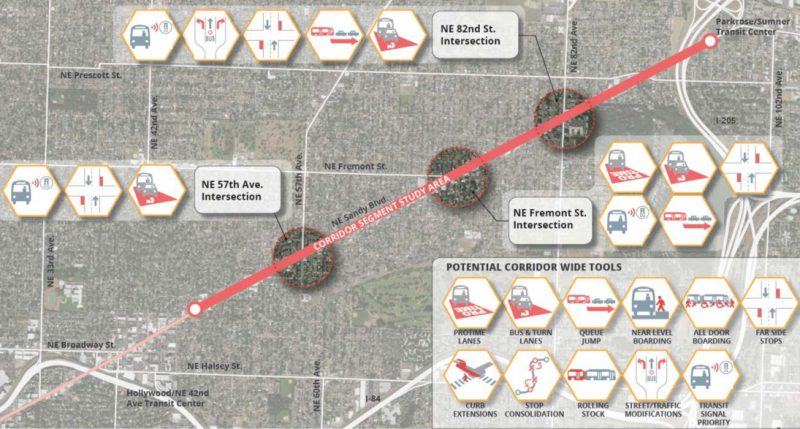
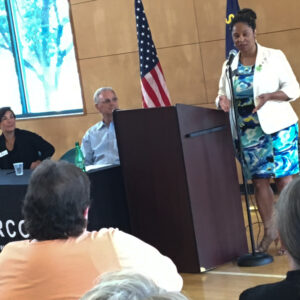
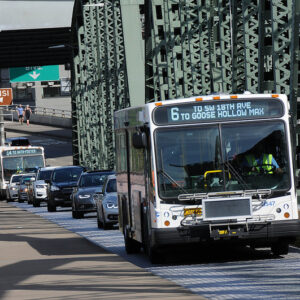
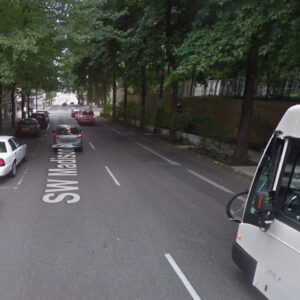
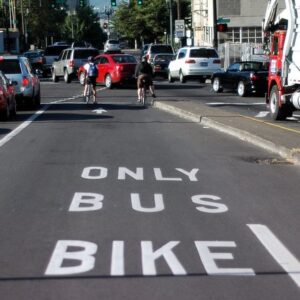
Thanks for reading.
BikePortland has served this community with independent community journalism since 2005. We rely on subscriptions from readers like you to survive. Your financial support is vital in keeping this valuable resource alive and well.
Please subscribe today to strengthen and expand our work.
Interesting and thought provoking article. Thanks!
I had this thought. Of all the types of vehicles on the road, buses are, and should be, the most able to safely share the road with cyclists. Because: bus movements are predictable, bus drivers are trained professional operators, their actions are/can be monitored with cameras and the rules enforced, and because on even a busy transit route, you’ll only have a bus coming by every few minutes or so.
So, let’s suppose you have a bike lane next to a traffic lane, and assume that the bike lane is not “protected” – it is separated only by a painted line. If that traffic lane is a bus-only lane, might that not be safer and more comfortable for cyclists than if it is a general purpose traffic lane used by everyone from private cars to box trucks? With appropriate training for the bus drivers, appropriate design of floating bus stops, and less congestion allowing bus drivers to stay on schedule while maintaining safe speeds, I think a bus-only lane can definitely be very compatible with an adjacent bike lane, even an “unprotected” bike lane. In fact, I could see bus-only lanes serving as 10 foot wide “protection” for the bike lane!
That would be nice. I generally feel safer around buses in Portland (not so in other cities) than regular traffic while biking.
I’d rather share the road with 100 Trimet drivers than a thousand typical drivers (roughly assuming a 1:10 occupant ratio, so fewer buses needed). The training, generally more engagement with the act of driving, etc., Trimet drivers are generally more courteous despite the increased “conflict” on pulling in/out of stops.
Experience from the UK and locally here in Victoria shows that bus-bike lanes are just as bad as regular unprotected bike lanes.
Here’s a thought:
Make SE 26th from Gladstone to Clinton bus (#10) and bike only.
No cars.
No trucks.
I love this idea. Though, the more likely street they would choose would be 28th, considering what they’ve already done on 28th (intersection at Powell, section between Gladstone and Holgate), and what they plan on doing with 26th (removing bike lanes).
This is great to read about! It seems plain that Portland needs to get a lot more serious about transit. I think th bike/bus lanes could work well, and I think PBOT may be able to do a great design if they start from the position that these are bus/bike priority streets and parking, freight and personal vehicles will not be accommodated. PBOT really fails the worst when they try to please everyone without clear goals.
You don’t think road diets and bike highways (greenways) are serious enough? If they truly wanted change it would and probably start by bikes staying on greenways, dieted roads going back to 4 lanes with a bus only lane and no auto parking and an auto lane.
As for protected bike lanes, i pass every moment I get to ride on the sad story of a protect lane on SW/NW 2nd. If you thought the blind right was bad just imagine the blind everything… including the peds that walknin them when there is a sidewalk. No thanks.
And VZ, it killed more people last year on our roads since 2005.
VZ didn’t kill more people, the poor implementation of VZ did. I see a lot of negative comments about VZ in Portland (mostly on other sites), but the problem isn’t VZ, it’s the city’s half-arsed approach to it. If they actually went all-in we would get some drastic changes that would piss off a lot of drivers but would actually make things much more efficient for alternate modes and be safer for everyone. But the leaders feel like that would be committing political suicide so they they make a show of throwing crumbs to VZ advocates while tip-toeing around drivers.
And, in a way, it’s hard to blame them. Most big changes would probably take a long time to fully implement (which means even longer for the areas to reap the full benefits), and in that time all of the drivers (majority of voting public still) would be calling for their heads. When the infrastructure has for so long been focused on moving one mode more efficiently, it’s hard to get people to wrap their heads around changing it. Tell them it will make it safer for them (“but my new car has 20 airbags… and I’ve never died in a car crash before, but I have been late to work, so I’d rather be able to drive faster”); tell them it will be safer for other road users (“they shouldn’t be on the road then if they’re not in a car. Physics!!!”); it will make the areas more livable (“but I don’t live there, I just need to drive through it”); or any other of the numerous reasons these changes should be done… (“but cyclists don’t even pay for the roads, plus you should have license plates and insurance!”) – wait, how did we get back to that?
My biggest complaint about PBOT is that not only are they no longer very innovative, but they can be unusually stupid about how traffic operates in their favorite places of Amsterdam and Copenhagen – they focus so much on bikes moving on residential streets that they fail to note how Dutch and Danish bus and car traffic moves.
You know, it’s too bad PBOT couldn’t take a long street segment like Lincoln-Herrison-4M, from Ladd’s Addition to Gresham/174th, and turn it over to the Parks Bureau and have them designate it a linear park with a 14 mph speed limit – slow enough that bike and peds would have priority in a reasonable degree of safety and comfort, but cars could still access local driveways and onstreet parking, even as they crawl along. Just an idea I got from attending a vision-zero workshop here in NC.
Related to that is to make inner Division and outer Powell bus and bike-only, restricting car and truck traffic to local deliveries only, with frequent painted roundabouts like you might find at City Repair sites – nothing that would slow a bus down, but certainly make car drivers hesitate.
I love the idea of along street conversion to someting like a next generation greenway- but please keep it FAR away from PP&R. They do not get bikes and they do not get transportation. They did a truly horrible job planning the NP Greenway, and possibly made things worse. Their planned route flies in the face of efficient transportation in the name of recreation, and simultaneously sacrifices any sort of preference of safety/beauty/pleasantness in the name of transportation. They were in thrall to their engineer consultants and wound up with zero creative options and recommending some of the worse options for the complex segments.
anybody else ever been riding right next to a bus when the air brake compressor releases at high dB? could obviously happen with any vehicle that’s got air brakes, but it’s a very unpleasant and potentially dangerous situation. that it leaves my ears ringing suggests permanent hearing damage. happens to me regularly where bus and bike routes coincide.
maybe a small quibble, but maybe also a reason to either separate bikes and buses or add some sort of muffler to those compressors.
I would like to know why it seems like the buses used by TriMet had no thought put into reducing the deafening noises that come out of them. I would rather take a large step up than hear the shriek of the bus kneeling. The engines are also extremely loud.
Some people cannot deal with a large step (Raises hand). So, a redesign of the kneeling system is in order, since noise equals wasted energy.
The solution to the large-step problem is BRT. The stations have raised curbs that meet the relatively low floors of the buses. You can roll a wheelchair right on.
You don’t need full-on heavy BRT to do it, either. Arterial BRT (aka “BRT lite”, derided by purists far more than it deserves) also has this. In the Twin Cities, both our Red Line (hBRT) and A Line (aBRT) have level boarding at the front and rear doors.
I’m about the farthest thing from an Ayn Rand free market type but this is one area we can safely say a more competitive market would vastly improve matters. There’s ZERO innovation and progress in the domestic bus manufacturing market presently as there’s only two companies playing… New Flyer and Gillig. And even these two share all the same supply chain. They just don’t care and the product sucks.
It could be something as simple as routing the air pressure release to the top of the bus, near the center.
I’m sure there’s a fairly benign and stupid reason they can’t do this. Everyone complains about the noise. TriMet is but one (small) of many customers. There’s no way they could reengineer such a complex system for one buyer.
They simply have not been incentivized to quiet the buses, either monetarily or legally.
Adding a muffler to the pneumatic blowoff is very easy, but it costs enough that it won’t happen unless it gets regulated on.
This opens up another issue on urban noise.
Current laws punish individuals for being loud (music, parties, loud exhaust, home improvement/construction) but do nothing to address the massive amount of sound created by car tires at highway speeds, air brakes of freight trucks, railroads, and other heavy industries.
OSHA and other agencies have regulations for employees in loud/hazardous environments, and these regulations work.
We need the same thing for urban, outdoor noise.
One of the most disruptive sources of urban noise is late night pick up of garbage and recycling at businesses and apartment buildings. Ironically, this business is heavily regulated in Portland, so controlling noise should be relatively straightforward compared to other sources. And yet… we don’t seem to have the will to do anything.
My hope is that the bus fleet gradually switches to electric which will address noise and pollution issues, and to articulated buses which will increase capacity.
Our city just bought 6 electric buses – nearly noiseless. I saw a new police motorcycle the other evening, it made less noise than a cat. Before I left Portland, I saw an electric Doritos delivery truck in East Portland – saw it before I could hear anything.
Agreed, outside officially-designated residential areas garbage pickup happens at crazy hours. When we lived at Johns Landing, garbage trucks regularly emptied dumpsters at 2:30am, at a commercial building across the parking lot overlooked by the bedroom window of our condo.
My wife finally went out and talked to the driver to ask if he could try to be less noisy in slamming the dumpster around, and he replied, “You live in the city! How can you complain about noise?”
I guess to some non-urbanites, it’s a foreign concept that most of the city is actually very quiet at night.
One of the new urban solutions to grid-lock is more use of the streets at night by commercial activities. So, in increasingly urban Portland, you can expect the future to be noisier at night. Plus, more people and density = more garbage cans to empty.
This might work better if we used quiet trucks and plastic bins. But I would favor restricting garbage pickup in residential areas between 10PM and 8AM.
It also means more people living in places that didn’t previously have many residents. Which means activities like garbage collection that make large amounts of noise may need to learn to be more sensitive to their impact on sleeping humans.
Lucky you. In my apartment complex, we have lots of residents getting back from the bars at 2-3 am and others heading off to work at 4:30 am, all with rap coming out of their speakers and car alarms going off. Compared to all that, the garbage trucks are the least of my worries.
1000% agree with you Ken S. But bear in mind one of the major reasons TriMet selected the bus model they have been buying since 2010 (Gillig BRT) is that it was substantially quieter than the competition and compared to the outgoing buses, a huge improvement with regard to interior and exterior noise pollution.
I fully support the red lane, bus-only lanes, but does Portland have the political will to implement this? Even simple buffered bike lanes screams of rage and panic from the general public, and that’s 2 stripes of white paint. Imagine the outcry of taking away lanes from major arteries, long lines of drivers impatiently waiting while the lane next to them in nearly empty. It would be a necessarily painful step to transitioning away from auto-dominated transpo, but be do we have the will.
good point Alan. But you’re forgetting that the irrational rage directed at cycling-related projects is unique to cycling-related project. That’s because of the deep and pervasive bias against bicycle riders in American culture. That same bias doesn’t exist against bus riders.
similar reason why we never talk about a walking tax, but we have a bike tax.
While I’ll agree on most of those points, I’d guess the general driving public would still be up in arms if a lane over the Hawthorne Bridge was turned into a bus only lane. That irrational rage may not exist for transit users, but it would likely erupt over transit infrastructure if driving lanes get taken away. Like I said, I think it would be a necessary pain in order to shift our culture to one of non-auto-primacy, (and I look forward to that day) but I don’t think we have the political will at present.
Look at the Tillicum. If you watch that bridge, it is easy to see it with not one soul on it, frequently: no bus, no train, no car, no bike, no ped – nada. This during the day. No other bridge in town has this infrequency of use. But, I’m not aware of any anti-transit rage against it…
Can you point to a similar project that seemed to benefit a small group (that many may feel is entitled) to the detriment of a larger group, that changed the way residential streets work to a similar degree, where residents were not upset?
I think people are not upset about this project because it is bicycle-related, but because it changes the way people interact with their homes. It feels personal, and some feel this project was move forward without consultation.
I want to be very clear that I support this project, but I have listened to the people who don’t, and I don’t think opposition is particularly anti-bike.
You’re right – It’s anti-change, as usual. People like what they are used to and don’t like to see something different, as conservative as cats, no matter their political affiliation.
I’d change the color related line to: “PBOT took this same step with green for a handful bike lanes (and several bike boxes).” We really don’t have that many, and those that we have tend to fade in about a year. Have you taken a look at the SE Madison/Grand intersection lately? Not to mention the 10 months last year where SW Oak st remained ungreen and unpainted in any color, including the absence of same.
Our streets are narrow and our population is growing. While I would support giving up a lane on Sandy (for example) for buses, it is far from clear to me that it will cause enough people to change modes to make the system work better after the conversion. There are a lot of reasons why people don’t like the bus, and travel time is only one.
I believe that fixed route/schedule buses are going to disappear, so it’s hard to get to worked up about this idea one way or the other.
I think it’s just time PBOT stood up and said plainly “no” you don’t get to have on street parking in front of your stupid store. If you are on a busy throughfare you just don’t get that. No amount of que jumping, bike boxes, TSP, Lane reconfigs or ped crossings will make up for the delay caused by storing cars on busy streets while busses full of people are stuck for hours on end. It’s the simplest and most effective answer to the transit crisis
What we need is a dictator. One that rides the bus.
Why does PBOT permanently remove the car parking spots on West Burnside in downtown to use as bus lanes? I use bus # 20 and it is slow downtown.
why does PBOT not permanently remove, i meant
I take the 20 bus sometimes. I can’t think of where on West Burnside there is curbside parking that slows the 20 bus – in fact, I’m not sure where there is any curbside parking on West Burnside in downtown?
Tangentially, I wish the city would revisit the couplet concept for West Burnside and NW Couch. That would give West Burnside room for one-way car and bus lanes, a dedicated (two-way) bike lane, wider sidewalks . . .
I am not in favor of 2-way cycle-tracks, but I loved the 3-lane cross-section concept for West Burnside from Park Ave west. This would be one motor vehicle lane in each direction, a center turn lane, and bike lanes.
I second this!
2-way cycle tracks, instead of a bike lane on each side of the auto lanes, are a bummer to navigate. If you need to exit the cycle track to make a turn, you may be blocked by oncoming bikes or autos. It’s my only real issue with Better Naito.
I think any new bridges should take queues from the new Sellwood bridge. It’s a really pleasant ride, has plenty of space for cars, bikes, foot traffic, ingress/egress is pretty seamless for all modes.
There is curb parking on W. Burnside out front of Dante’s and it is a huge cluster every rush hour what with hapless TNC cars parked every which way in the travel lanes during all hours. PBOT did a trial run of installing delineators here to force EB Burnside traffic to turn right on 3rd (except bus) but they were quickly uprooted and not replaced. So too pavement markings. Combined with no enforcement and you have basically no transit priority even though it is signed as such.
There are so many idiotic places where we have parking not the least of which is the Transit Mall and drop off zones for major hotels which routinely interfere with transit priority (Nines, Hilton hotels). The Hilton Hotel just finished a multi-million-dollar remodel and yet they still kept the same incredibly stupid entrance on the east side. Why didn’t anyone make them sign an agreement to move the location upon next major remodel and eminent domain that east entrance back in ’09 when they redesigned the mall?
Really silly that we have literally invested billions of dollars in transit only to have key parts of the system throttled by mid-level city bureaucrats and greedy developers. What it all comes down to is a lack of political leadership. Yeah, some people are going to be mad. So what. I’m mad every day I have to spend hours sitting in traffic because joe sixpack wants a free parking spot in front of his shop or loft. Pick your side!
And, now that I think about it, there is also curbside parking on W Burnside in front of the missions between 2nd and 3rd. Ambulances and fire trucks are frequently parked there.
Jonathan,
I nominate your tagline from this article for the quote of the year that best describes the problems with our entire modern urban situation.
“Too much driving is screwing everything up.”
I bet all the Amazon delivery and Uber drivers will love these new open bus lanes – what a perfect spot to pull over for just a minute….
We desperately need better street designers who will not decrease the flow of traffic. Who was the idiot that approved that clusterfart at Belmont & 39th eastbound? There was once a clearly defined left turn, right turn, and center lane. Now, if one person at the front of the line is turning right, all the buses, cars, bikes, and motorcycles that could have made it through the light have to sit there, going nowhere. I’ve almost been smashed on my bike several times since the new design where right turners now have to merge back into the center lane because the right turn lane is gone. And what’s up with that westbound stop at Belmont & 34th westbound? The bus stop was just fine where it was in front of Hodas, not blocking traffic. Now it is right past the stoplight in front of the Belmont Inn, out in the middle of the road so no one can get by? How is this an improvement?
Congestion is a good thing. By increasing congestion at busy intersections, overall traffic slows down, increasing the ease of walking and bicycling relative to car driving. In addition, pavement use is diffused over a greater, more progressively democratic area, into residential areas, thus reducing the need for immediate street repaving and allowing the whole street system to mature organically in a holistic equitable fashion, so that inner Portland will soon resemble East Portland, creating a harmonic conversion of an ideal urban Nirvana.
Congestion also provides more time for peaceful contemplation, for inner dialog, for oneness with oneself. It teaches patience, and helps one let go of earthly concerns, such as the doctor’s appointment one is missing, or tardiness for work. We can learn to go without going, to move without moving, and to be without being. Yes, congestion is good, it is what helps us become better beings, both in body and spirit, while filling the air with the perfume of benzene and ozone, allowing us to share with others what we are experiencing ourselves.